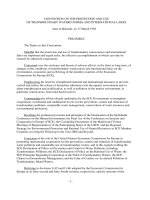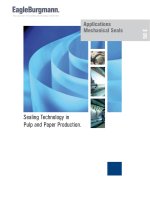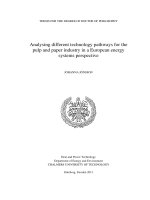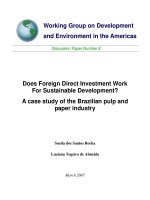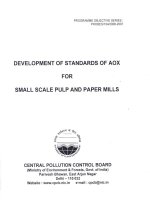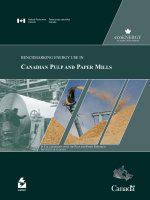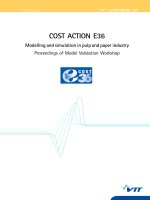BENCHMARKING ENERGY USE IN CANADIAN PULP AND PAPER MILLS doc
Bạn đang xem bản rút gọn của tài liệu. Xem và tải ngay bản đầy đủ của tài liệu tại đây (855.93 KB, 66 trang )
IN COLLABORATION WITH THE PULP AND PAPER RESEARCH
INSTITUTE OF CANADA
BENCHMARKING ENERGY USE IN
CANADIAN PULP AND PAPER MILLS
For more information or to receive additional copies of this publication, contact
Canadian Industry Program for Energy Conservation
c/o Natural Resources Canada
580 Booth Street, 18th Floor
Ottawa ON K1A 0E4
Tel.: 613-995-6839
Fax: 613-992-3161
E-mail:
Web site: oee.nrcan.gc.ca/cipec
or
Pulp and Paper Research Institute of Canada
570 St-Jean Boulevard
Pointe-Claire QC H9R 3J9
Tel.: 514-630-4101
E-mail:
Web site: www.paprican.ca
Library and Archives Canada Cataloguing in Publication
Benchmarking energy use in Canadian Pulp and Paper Mills
Text in English and French on inverted pages.
Title on added t.p.: Analyse comparative de la consommation d'énergie dans le
secteur canadien des pâtes et papiers
ISBN 0-662-69589-5
Cat. No. M144-121/2006
1. Pulp mills – Energy consumption – Canada.
2. Paper mills – Energy consumption – Canada.
I. Pulp and Paper Research Institute of Canada.
II. Canada. Natural Resources Canada.
III. Title: Analyse comparative de la consommation d'énergie dans le secteur canadien des
pâtes et papiers.
TJ163.5.P37B46 2006 333.79’65 C2006-980017-0E
1. Photo courtesy of the Pulp and Paper Research Institute of Canada
2. Photo courtesy of Catalyst Paper Corporation
© Her Majesty the Queen in Right of Canada, 2008
Recycled paper
Natural Resources Canada’s Office of Energy Efficiency
Leading Canadians to Energy Efficiency at Home, at Work and on the Road
TABLE OF CONTENTS
FOREWORD . . . . . . . . . . . . . . . . . . . . . . . . . . . . . . . . . . . . . . . . . . . . . . . . . . . . . . . . . .1
1. INTRODUCTION . . . . . . . . . . . . . . . . . . . . . . . . . . . . . . . . . . . . . . . . . . . . . . . . . . . . . .4
2. METHODOLOGY . . . . . . . . . . . . . . . . . . . . . . . . . . . . . . . . . . . . . . . . . . . . . . . . . . . . .8
3. RESULTS . . . . . . . . . . . . . . . . . . . . . . . . . . . . . . . . . . . . . . . . . . . . . . . . . . . . . . . . .14
4. DISCUSSION . . . . . . . . . . . . . . . . . . . . . . . . . . . . . . . . . . . . . . . . . . . . . . . . . . . . . .28
5. INTERPRETATION OF THE RESULTS . . . . . . . . . . . . . . . . . . . . . . . . . . . . . . . . . . . . . . . .34
5.1 How do the results affect my mill? . . . . . . . . . . . . . . . . . . . . . . . . . . . . . . . . . . .35
5.2 What steps do I take? . . . . . . . . . . . . . . . . . . . . . . . . . . . . . . . . . . . . . . . . . . . . .36
6. REFERENCES . . . . . . . . . . . . . . . . . . . . . . . . . . . . . . . . . . . . . . . . . . . . . . . . . . . . . .40
APPENDICES . . . . . . . . . . . . . . . . . . . . . . . . . . . . . . . . . . . . . . . . . . . . . . . . . . . . . . . .41
APPENDIX A. AREA DEFINITIONS . . . . . . . . . . . . . . . . . . . . . . . . . . . . . . . . . . . . . . . . . . .42
APPENDIX B. SAMPLE CALCULATION . . . . . . . . . . . . . . . . . . . . . . . . . . . . . . . . . . . . . . . .50
APPENDIX C. ENERGY BENCHMARKING SURVEY INSTRUCTIONS . . . . . . . . . . . . . . . . . . . . .56
DISCLAIMER
The information contained in Benchmarking Energy Use in Canadian Pulp and Paper Mills and the Energy
Benchmarking Survey Tool on the CD-ROM is intended to be used solely as an educational tool to help companies
determine approximately how their facility compares against industry averages. The information is not intended to
replace the findings of a formal energy benchmarking study at a facility. Under no circumstances will the
Government of Canada or the Pulp and Paper Research Institute of Canada (Paprican) be liable either directly or
indirectly to any person who uses such information.
BENCHMARKING ENERGY USE IN CANADIAN PULP AND PAPER MILLS
List of Figures
Figure 1-1 Energy inputs and outputs of a pulp and paper mill . . . . . . . . . . . . . . . . .4
Figure 2-1 Energy conversion areas and manufacturing areas of the
pulp and paper mill . . . . . . . . . . . . . . . . . . . . . . . . . . . . . . . . . . . . . . . . .9
Figure 2-2 Energy and fibre inputs and outputs for a mechanical pulping area . . . .10
Figure 3-1 Electricity consumption for a mechanical pulping area producing
TMP for newsprint . . . . . . . . . . . . . . . . . . . . . . . . . . . . . . . . . . . . . . . .17
Figure 3-2 Fuel consumption for a kraft recausticizing area . . . . . . . . . . . . . . . . . . .18
Figure 3-3 Thermal energy consumption of a kraft pulping area with a
continuous digester . . . . . . . . . . . . . . . . . . . . . . . . . . . . . . . . . . . . . . . .19
Figure 3-4 Thermal energy consumption of a kraft pulping area with a
batch digester . . . . . . . . . . . . . . . . . . . . . . . . . . . . . . . . . . . . . . . . . . . .19
Figure 3-5 Thermal energy consumption for a kraft pulp bleaching area for
softwood pulp . . . . . . . . . . . . . . . . . . . . . . . . . . . . . . . . . . . . . . . . . . . .20
Figure 3-6 Net thermal energy production for a mechanical pulping area
producing TMP for newsprint . . . . . . . . . . . . . . . . . . . . . . . . . . . . . . . .21
Figure 3-7 Thermal energy consumption for a paper machine area producing
newsprint . . . . . . . . . . . . . . . . . . . . . . . . . . . . . . . . . . . . . . . . . . . . . . . .22
Figure 3-8 Thermal energy consumption for a paper machine area producing
uncoated groundwood specialties . . . . . . . . . . . . . . . . . . . . . . . . . . . . . .22
Figure 4-1 Electricity consumption for manufacturing bleached kraft
market pulp . . . . . . . . . . . . . . . . . . . . . . . . . . . . . . . . . . . . . . . . . . . . . .30
Figure 4-2 Fuel consumption for manufacturing bleached kraft market pulp . . . . . .30
Figure 4-3 Thermal energy consumption for manufacturing bleached kraft
market pulp . . . . . . . . . . . . . . . . . . . . . . . . . . . . . . . . . . . . . . . . . . . . . .31
Figure 4-4 Electricity consumption for manufacturing newsprint from TMP . . . . . .32
Figure 4-5 Net thermal energy consumption for manufacturing newsprint
from TMP . . . . . . . . . . . . . . . . . . . . . . . . . . . . . . . . . . . . . . . . . . . . . . .32
Figure B-1 Energy conversion and manufacturing areas of a mill producing
newsprint from TMP . . . . . . . . . . . . . . . . . . . . . . . . . . . . . . . . . . . . . . .50
BENCHMARKING ENERGY USE IN CANADIAN PULP AND PAPER MILLS
List of Tables
Table 3-1 Distribution of mills by pulping process and product type . . . . . . . . . . .14
Table 3-2 Data quality . . . . . . . . . . . . . . . . . . . . . . . . . . . . . . . . . . . . . . . . . . . . . .15
Table 3-3 Electricity consumption of pulp manufacturing areas . . . . . . . . . . . . . . .16
Table 3-4 Fuel consumption of pulp manufacturing areas . . . . . . . . . . . . . . . . . . .17
Table 3-5 Thermal energy consumption of pulp manufacturing areas . . . . . . . . . . .18
Table 3-6 Thermal energy production of pulp manufacturing areas . . . . . . . . . . . .20
Table 3-7 Electricity consumption of product manufacturing areas . . . . . . . . . . . .21
Table 3-8 Fuel consumption of product manufacturing areas . . . . . . . . . . . . . . . . .22
Table 3-9 Thermal energy consumption of product manufacturing areas . . . . . . . .23
Table 3-10 Electricity consumption of common areas . . . . . . . . . . . . . . . . . . . . . . .23
Table 3-11 Fuel consumption of common areas . . . . . . . . . . . . . . . . . . . . . . . . . . . .23
Table 3-12 Thermal energy consumption of common areas . . . . . . . . . . . . . . . . . . .24
Table 3-13 Electricity consumption of boiler areas . . . . . . . . . . . . . . . . . . . . . . . . . .24
Table 3-14 Fuel consumption of boiler areas . . . . . . . . . . . . . . . . . . . . . . . . . . . . . .24
Table 3-15 Thermal energy consumption of boiler areas . . . . . . . . . . . . . . . . . . . . .25
Table 3-16 Electricity consumption of kraft recovery boilers . . . . . . . . . . . . . . . . . .25
Table 3-17 Fuel consumption of kraft recovery boilers . . . . . . . . . . . . . . . . . . . . . .25
Table 3-18 Net thermal energy production of kraft recovery boilers . . . . . . . . . . . .25
Table 3-19 Thermal energy consumption of generators . . . . . . . . . . . . . . . . . . . . . .26
Table 3-20 Steam consumption of deaerators . . . . . . . . . . . . . . . . . . . . . . . . . . . . .26
Table 4-1 Energy consumption and production for unbleached kraft pulp . . . . . . .28
Table 4-2 Energy consumption and production for bleached kraft pulp . . . . . . . . .29
Table 4-3 Energy consumption and production for manufacturing bleached
kraft market pulp . . . . . . . . . . . . . . . . . . . . . . . . . . . . . . . . . . . . . . . . . .29
Table 4-4 Energy consumption and production for manufacturing newsprint . . . .31
Table A-1 Technology descriptors–pulp manufacturing areas . . . . . . . . . . . . . . . . .42
Table A-2 Technology descriptors–product manufacturing areas . . . . . . . . . . . . . . .45
Table A-3 Technology descriptors–common areas . . . . . . . . . . . . . . . . . . . . . . . . .47
Table A-4 Technology descriptors–energy conversion areas . . . . . . . . . . . . . . . . . .48
Table B-1 Energy data for a newsprint mill . . . . . . . . . . . . . . . . . . . . . . . . . . . . . .52
Table B-2 Reconciled energy data for a newsprint mill . . . . . . . . . . . . . . . . . . . . . .53
Table B-3 Specific energy data for a newsprint mill . . . . . . . . . . . . . . . . . . . . . . . .55
Table B-4 Energy consumption of the power boiler . . . . . . . . . . . . . . . . . . . . . . . .55
BENCHMARKING ENERGY USE IN CANADIAN PULP AND PAPER MILLS
F
OREWORD
1
FOREWORD
The Canadian pulp and paper sector, founded 200 years ago, has become an important
component of the Canadian economy. Pulp and paper manufacturing is highly integrated
with its allied sectors in the forest products industry—forestry and wood products.
The forest products industry contributes 3 percent of Canada’s gross domestic product.
The industry operates in communities throughout Canada, providing direct employment
for 360 000 Canadians.
The pulp and paper sector is one of the most energy-intensive sectors, consuming
approximately 30 percent of the industrial energy used in Canada. Because energy is a
significant production-cost component (about 25 percent), the sector has made efforts to
reduce its fuel costs by switching to renewable biomass sources (by-products of the
production process) and energy efficiency improvements.
Pulp and paper manufacturing is unique among manufacturing sectors in that it sources
57 percent of its energy consumption from biomass. As well, the sector reduced its energy
use by an average of 1 percent annually since 1990 through improvements in energy
efficiency. These achievements have been well documented by the industry and through
initiatives such as the Canadian Industry Program for Energy Conservation (CIPEC).
Although its progress on energy conservation is impressive, the pulp and paper sector wants
and needs to go further. The sector aims to produce all the energy it requires, to ensure its
long-term competitiveness in the global market. In fact, the industry has the potential to
become a net exporter of energy. It has the largest industrial cogeneration capacity in
Canada and has the potential for further installations.
How can the industry become more energy efficient? It must implement both proven and
new technology. However, mills must understand how they use energy before they adopt
new energy sources or technology.
That is where energy benchmarking can help. This benchmarking study, conducted by the
Pulp and Paper Research Institute of Canada (Paprican), shows how the sector uses energy.
The study found causes of wasted energy, but also revealed that sector best practices are
near the theoretical minimums for certain process segments.
Its results will help Canada’s pulp and paper manufacturers adopt today’s best practices
more consistently across the sector while investigating the best practices of tomorrow.
INTRODUCTION
1
4
BENCHMARKING ENERGY USE IN CANADIAN PULP AND PAPER MILLS
1
INTRODUCTION
1. INTRODUCTION
A benchmarking study compares the performance of a mill with its competitors or with a
model mill that has new technology.
The results can be a valuable motivating force for change, both in operating practice and
capital investment. A mill can assess its operating costs (energy) and environmental impact
(greenhouse gas emissions) relative to its competitors and relative to the lowest values that
can be obtained practically.
Governments and pulp and paper trade associations, such as the Forest Products
Association of Canada (FPAC), collect data about energy use and about pulp and paper
production for economic policy and planning. See Figure 1-1.
These groups collect data on
• purchased energy (electricity, steam, fossil fuels)
• self-generated energy (hog fuel, sludge, spent pulping liquor, hydroelectric power)
• sold energy (electricity, steam)
• pulp and paper production
These data can be used to calculate the energy intensity of a mill, by dividing the mill’s
energy consumption by its pulp and paper production.
The energy intensity can be used for global benchmarking even when you do not know
specifics about the products and manufacturing processes.
1
Global benchmarking makes an
initial assessment of where the mill’s operations rank in the industry. However, this
benchmarking can identify only the potential for energy savings, not where they can be
achieved.
Figure 1-1 Energy inputs and outputs of a pulp and paper mill
Fuel
Pulp and Paper Mill
Electricity
Steam
Electricity
Steam
Product
1
Connaghan, C. and R. Wunderlich. “Developing, Implementing and Maintaining an Energy Efficiency Program” Energy Cost Reduction in the Pulp and Paper Industry,
Browne, T.C and P.N. Williamson, eds. Pulp and Paper Research Institute of Canada, Montréal, 1999.
BENCHMARKING ENERGY USE IN CANADIAN PULP AND PAPER MILLS
I
NTRODUCTION 1
5
To identify where process improvements and energy savings can be achieved, benchmarking
comparisons should be made for individual process areas in the mill.
For example, in a thermomechanical pulp (TMP) newsprint mill, the total steam demand is
determined by the performance of both the TMP reboiler and the paper machine dryer.
High steam consumption can result from poor performance of the reboiler or the dryer,
and a global benchmarking survey cannot determine which area requires improvement.
However, by comparing these two individual process areas you can determine which area
requires improvement.
In this report, the Pulp and Paper Research Institute of Canada (Paprican) describes a
method for benchmarking the energy use for process areas in pulp and paper mills.
Paprican then presents the results of a benchmarking survey of energy use in Canadian pulp
and paper operations.
In “Methodology,” the benchmarking method is explained. Energy use in pulp and paper
mills was analysed by examining energy conversion areas and manufacturing areas.
In “Results,” the results of the detailed data analysis in manufacturing areas and energy
conversion areas from 49 mills are presented.
In “Discussion,” the energy consumption to produce two product grades, kraft pulp and
newsprint, from TMP is determined by combining the relevant manufacturing areas at mill
sites.
In “Interpretation of the Results,” reasons are given for why the results for each area
benchmarked may differ.
“How do the results affect my mill?” presents information about how to use the results
from the benchmarking study.
“What steps do I take?” provides a seven-step process explaining how you can start to find
opportunities for energy efficiency improvements.
“Appendix A. Area definitions” lists the definitions for the process areas in the pulp and
paper mill.
Sample calculations are described in “Appendix B. Sample calculation.”
“Appendix C. Energy benchmarking survey instructions” concludes the report with
instructions on how to benchmark your facility using the enclosed CD-ROM, which
includes an Excel workbook. The workbook contains spreadsheets (six visible and one
hidden) with step-by-step instructions. The information is not intended to replace the
findings of a formal energy benchmarking study at a facility.
METHODOLOGY
2
8
BENCHMARKING ENERGY USE IN CANADIAN PULP AND PAPER MILLS
2
METHODOLOGY
2. METHODOLOGY
The Pulp and Paper Research Institute of Canada (Paprican) developed a methodology to
benchmark the energy use in pulp and paper mills by process area.
2
This method is based on the approach developed by the International Energy Agency
(IEA) Programme on Advanced Energy-Efficient Technologies for the Pulp and Paper
Industry for life-cycle studies.
3
Data are collected on
• purchased energy
• self-generated energy
• sold energy
• pulp and paper production
With this information, you can make global benchmarking comparisons for mill operations.
The energy and fibre resources are allocated to areas. This allows benchmarking
comparisons for individual areas in a mill and for product grades.
The benchmarking method has four steps:
• establish process areas
• collect data
• allocate and reconcile data
• calculate energy consumption
Establish process areas
The first step is to divide the pulp and paper mill into process areas. The areas are described
in Appendix A.
Figure 2-1 shows the process areas of a mill that produce newsprint and kraft market pulp
from TMP and kraft pulp.
There are two kinds of process areas: energy conversion areas and pulp and paper
manufacturing areas. In the energy conversion areas, purchased and self-generated energy
are converted to steam and electricity for use in the manufacturing areas or for sale. The
energy conversion areas include power and recovery boilers, a backpressure turbine and a
deaerator.
In the manufacturing areas of pulp and paper manufacturing operations, energy resources
(fuel, steam and electricity) and fibre resources are used to produce newsprint and kraft
market pulp.
2
Francis, D.W. Method for Benchmarking Energy Usage in Pulp and Paper Operations, PAPTAC Midwest Branch Meeting, Thunder Bay, Ontario, September 25–27, 2002.
3
IEA Programme on Advanced Energy-Efficient Technologies for the Pulp and Paper Industry. “Recommended Methods for Energy Reporting in Pulp and Paper Industry,
Summary Report” Assessment of Life-Cycle-Wide Energy-Related Environmental Impacts in the Pulp and Paper Industry, IEA, 1999.
BENCHMARKING ENERGY USE IN CANADIAN PULP AND PAPER MILLS
M
ETHODOLOGY 2
9
The manufacturing areas include
• wood preparation
• mechanical pulping
• kraft pulping
• bleaching
• evaporators
• recausticizing
• paper and pulp machines
• effluent treatment
• general areas (for example, buildings)
Figure 2-1 Energy conversion areas and manufacturing areas of the pulp and paper mill
Fuel
Electricity
Steam
Electricity
Steam
Product
Condensate
Condensate
Energy Conversion Areas
Power
Boiler
Kraft
Recovery
Boiler
Deaerator
Back
Pressure
Turbine
Manufacturing Areas
Mechanical
Pulping
TMP 1
Wood
Preparation
Mechanical
Pulping
TMP 2
Mechanical
Pulping
TMP 3
Kraft
Pulping
Kraft
Bleaching
Kraft
Recaust.
Paper
Machine
Kraft
Evaporators
Effluent
Treatment
General
Buildings
Pulp
Machine
Each of the energy conversion and manufacturing areas is defined by its product.
10
BENCHMARKING ENERGY USE IN CANADIAN PULP AND PAPER MILLS
2
METHODOLOGY
For example, the mechanical pulping area in Figure 2.2 produces TMP from electricity and
chips. The input boundary is the inlet of the chip bin; the output boundary is the pulp
storage tank after thickening.
The mechanical pulping area includes
• chip steaming
• refining
• screening
• rejects refining
There is also a reboiler for heat recovery from the refiner steam. Therefore, this mechanical
pulping area also produces steam from boiler feed water and electricity.
Figure 2-2 Energy and fibre inputs and outputs for a mechanical pulping area
Mechanical Pulping
TMP 1
Electricity
Chips
Boiler Feed
Water
Steam
Mechanical
Pulp
In Figure 2-2, the energy intensity of the process area is the energy consumption divided
by the pulp production. The energy intensity is calculated by using the reconciled data. For
each energy conversion and manufacturing area, technology descriptors are defined to
account for different energy use by different technologies. For example, in mechanical
pulping, the energy use varies relative to the pulping process and the heat recovery.
The pulping process descriptors for mechanical pulping are
• stone groundwood (SGW)
• pressurized groundwood (PGW)
• refiner mechanical pulp (RMP)
• thermomechanical pulp (TMP)
• chemithermomechanical pulp (CTMP)
• thermopulp or RTS
• other (specify)
BENCHMARKING ENERGY USE IN CANADIAN PULP AND PAPER MILLS
M
ETHODOLOGY 2
11
The heat recovery descriptors are
• primary refiners only
• mainline refiners only
• mainline and reject refiners
• none
These technology descriptors allow you to make benchmarking comparisons among areas
with the same technology (for example, TMP lines) or between areas with different
technologies (for example, between SGW lines and TMP lines). Similar technology
descriptors are defined for the other energy conversion and manufacturing areas. See
Appendix A.
Collect data
The second step is to collect data on energy inputs and outputs for the mill and for pulp
and paper production. This is the same information that is collected in global
benchmarking studies.
For the mill in Figure 2-1, the energy inputs can include fuel (purchased fossil fuel, self-
generated spent pulping liquor), electricity and steam. The energy outputs can include
electricity and steam.
Data are also collected on condensate input and output because the thermal energy input
to the mill is the steam input (for example, from a cogeneration plant) minus the
condensate returned to the steam supplier.
At most mills, engineers from Paprican visited the mill site for several days to collect the
energy and production data from mill staff and mill information systems. This practice
ensures a consistent method for the allocation of energy and fibre resources to the energy
conversion and manufacturing areas. However, for a few mills, the mill staff, in consultation
with a Paprican engineer, recorded the data.
At all mills, the data were recorded in a spreadsheet tool to facilitate data checking and data
reconciliation. Paprican collected data from 51 mills: 49 mills in Canada and 2 mills in the
United States that were similar to the Canadian operations of the same companies. These
mills represent 55 percent of Canadian production capacity and provided data for the
major pulping processes and product grades of the Canadian pulp and paper industry.
Allocate and reconcile data
The third step is to allocate the energy and fibre resources to the energy conversion and
manufacturing areas. For each area, data are collected on energy inputs and outputs and on
fibre inputs and outputs.
12
BENCHMARKING ENERGY USE IN CANADIAN PULP AND PAPER MILLS
2
METHODOLOGY
For the mechanical pulping area in Figure 2-2, the energy inputs are electricity and the feed
water to the reboiler; the energy output is the reboiler steam. The fibre input is chips from
wood preparation; the fibre output is TMP.
Ideally, all the energy inputs to the mill would be allocated to areas in the mill and to any
energy sales. That is, energy inputs and outputs would balance. Realistically, there will not
be a perfect energy balance because of instrument measurement errors and estimations
when measurements are unavailable.
The quality of the data is recorded when the energy and fibre data are collected:
• A–reliable instrumentation with good calibration
• B–less reliable instrumentation
• C–calculated by heat and material balance from measured values
• D–estimated when measurements are unavailable
This information is used to weight the corrections needed to reconcile the energy and fibre
data.
Calculate energy consumption
The fourth step is to calculate the specific energy consumption for each area from its
energy consumption and fibre production, by using the reconciled data. These results allow
the mill staff to identify where their operations are least efficient and thereby to identify
areas that require changes in operating procedures or capital investments. A sample
calculation for a newsprint mill is shown in Appendix B.
RESULTS
3
14
BENCHMARKING ENERGY USE IN CANADIAN PULP AND PAPER MILLS
3
RESULTS
3. RESULTS
The Pulp and Paper Research Institute of Canada (Paprican) collected energy and
production data from 51 mills on a quarterly basis. For most mills, Paprican collected data
for four consecutive quarters. For two mills, Paprican could collect data for only one
quarter. The data for these two mills were excluded from the analysis, leaving 49 mills in
the data set. This section presents the results of the energy benchmarking survey for the
manufacturing and energy conversion areas of the 49 pulp and paper mills.
Data analysis
Table 3-1 shows the distribution of mills by pulping process and product type for the
49 pulp and paper mills. Several mills had multiple pulping processes and multiple product
types.
Table 3-1 Distribution of mills by pulping process and product type
Total Mills in Data Analysis
Mills by Pulping Process
Mechanical Pulping
Kraft Pulping
Recycled Pulping
Sulphite Pulping
Mills by Product Type
Pulp
Newsprint
Paper (other than newsprint)
Board
49
28
24
10
4
27
20
17
5
The difference between the energy inputs (purchased and produced) and energy outputs
(consumed and sold) for a mill indicates how well the energy was allocated to the energy
conversion and manufacturing areas.
The average and 90th percentile values for the difference between energy inputs and
energy outputs are shown in Table 3-2. The largest differences were for steam and
condensate.
BENCHMARKING ENERGY USE IN CANADIAN PULP AND PAPER MILLS
R
ESULTS 3
15
There were problems in allocating the electricity to the areas. The power distribution and
metering were not arranged by area in some cases. Therefore, the total electricity
consumption was correct but the allocation to individual areas was not accurate for some
mills.
For example, some of the power for the kraft evaporators area were measured in the kraft
recovery boiler area. Therefore, the measurements of the electricity consumption for the
kraft evaporators are lower than the actual value, and the measured consumption for the
kraft recovery boiler is higher than the actual value. However, the power was measured
accurately in areas such as mechanical pulping and turbogenerators, where there was
significant electricity consumption or production.
Manufacturing areas
The energy consumption and production of the manufacturing areas are shown in Tables
3-3 to 3-12. The tables show the 25th percentile, median and 75th percentile specific
energies for each area.*
For most areas, the fibre allocated to the area was equal to the fibre produced by the area.
For kraft evaporators and recausticizing, the fibre allocation was the unbleached kraft pulp
produced in the kraft pulping area.
For the sulphite acid plant, the fibre allocation was the unbleached sulphite pulp produced
in the sulphite pulping area.
For the common areas, the fibre allocated was the total mill production.
The tables also show the energy values (adapted from recent literature)
4, 5
for the
manufacturing areas that use modern technology.
Table 3-2 Data quality
Electricity Fuel Steam Condensate
A
verage 2.40 1.00 5.70 2.50
90th Percentile 5.90 3.00 12.10 9.50
Energy Inputs – Energy Outputs (%)
†
†
T
here was a difference between energy inputs and energy outputs in data reconciliation.
* The k percentile is the value of a distribution with k percentage of the values equal to or below it. Thus, the 25th percentile value is equal to or greater than 25
percent of the values of the distribution; the median (50th percentile) value is equal to or greater than 50 percent of the values; the 75th percentile value is equal
to or greater than 75 percent of the values.
4
Towers, M.T. and D.W. Francis. Impact of Mill Modernization on Energy Use and Greenhouse Gas Emissions, PACWEST Conference,
Harrison Hot Springs, British Columbia, May 7–10, 2003.
5
Browne, T.C and P.N. Williamson, eds. Energy Cost Reduction in the Pulp and Paper Industry, Pulp and Paper Research Institute of Canada, Montréal, 1999.
Be careful when making direct comparisons of the energy data in this report with reports
of best practices. The data for best practices are derived from several sources, and those
sources can draw area boundaries in different ways, or they may apply only to specific
technologies.
In addition, the definition of thermal energy (the steam consumed minus the condensate
returned to the boiler) may not be the same in various reports. Consequently, use these
comparisons with best practices as general guides only.
16
BENCHMARKING ENERGY USE IN CANADIAN PULP AND PAPER MILLS
3
RESULTS
Table 3-3 Electricity consumption of pulp manufacturing areas
25th Percentile Median 75th Percentile Modern
Wood Preparation 9.50 22.20 31.60 22.00
Kraft Pulping – Continuous 150.50 179.50 221.30 161.00
Kraft Pulping – Batch 134.90 169.30 230.50 161.00
Kraft Pulping – M&D 166.00 190.90 208.70 NA
Kraft Evaporators – Indirect Contact 0.00 15.70 30.60 33.00
Kraft Evaporators – Direct Contact 10.00 24.50 44.70 NA
Kraft Recausticizing 23.20 32.10 47.90 56.00
Kraft Bleaching – Softwood 112.30 179.50 240.70 122.00
Kraft Bleaching – Hardwood 117.10 143.90 237.50 NA
Sulphite Pulping 226.50 766.40 1358.80 NA
Sulphite Acid Plant – 32.00 – NA
Mechanical Pulping – TMP for Newsprint 2508.60 2661.60 2786.80 2450.00 to 2600.00
Mechanical Pulping – TMP for Paper 2586.60 2943.20 3261.10 2650.00 to 2800.00
Mechanical Pulping – SGW 1690.80 1780.30 2081.70 1500.00 to 1800.00
Mechanical Peroxide Bleaching 84.10 133.80 232.50 NA
Recycled Pulping 256.10 344.20 428.60 460.00
Electricity Consumption (kWh/ODt)
†
†
The specific energy is the electricity consumed divided by the fibre produced or allocated to the area expressed on an oven-dried basis. The paper grades for
mechanical pulping – TMP for paper include uncoated groundwood specialties and printing and writing paper; some of the pulp may also be used for newsprint.
The energy consumption and production of various manufacturing areas are shown in
Figures 3-1 to 3-8. The mills that followed best practices used the least energy. The
variations in energy consumption for each area indicate the realistic potential for energy
reductions.
BENCHMARKING ENERGY USE IN CANADIAN PULP AND PAPER MILLS
R
ESULTS 3
17
The mechanical pulping areas in pulp manufacturing used the most energy. The
distribution of electricity consumption for the mechanical pulping area producing TMP for
newsprint is shown in Figure 3-1. The lowest electricity consumption value is suspect. The
variation of the remaining values is related to wood species primarily, not to operating
practices.
The largest fuel consumption for pulp manufacturing occurred in the kraft recausticizing
area. The fuel is used in the lime kiln. The distribution of fuel consumption for the kraft
recausticizing area is shown in Figure 3-2.
4500
4000
3500
3000
2500
2000
1500
1000
500
0
Electricity Consumption (kWh/ODt)
Mechanical Pulping Area – TMP for Newsprint
15913 17 21 25 29 33
Figure 3-1 Electricity consumption for a mechanical pulping area producing TMP for newsprint
Table 3-4 Fuel consumption of pulp manufacturing areas
25th Percentile Median 75th Percentile Modern
Kraft Recausticizing 1.96 2.15 2.34 1.70
Fuel Consumption (GJ/ODt)
†
†
The specific energy is the fuel consumed divided by the fibre produced or allocated to the area expressed on an oven-dried basis.
Annual Value Range of Quarterly Values
18
BENCHMARKING ENERGY USE IN CANADIAN PULP AND PAPER MILLS
3
RESULTS
4
3.5
3
2.5
2
1.5
1
0.5
0
Fuel Consumption (GJ/ODt)
Kraft Recausticizing Area
1357911 13 15 17 19 21 23 25
Figure 3-2 Fuel consumption for a kraft recausticizing area
Table 3-5 Thermal energy consumption of pulp manufacturing areas
25th Percentile Median 75th Percentile Modern
Wood Preparation 0.00 0.00 0.00 0.00
Kraft Pulping – Continuous 2.43 2.94 3.81 2.20
Kraft Pulping – Batch 4.33 4.94 5.64 3.50
Kraft Pulping – M&D 5.50 6.04 6.76 NA
Kraft Evaporators – Indirect Contact 5.03 5.91 7.06 3.20
Kraft Evaporators – Direct Contact 2.90 2.96 3.89 NA
Kraft Recausticizing 0.00 0.14 0.44 0.00
Kraft Bleaching – Softwood 2.57 3.41 4.65 1.70
Kraft Bleaching – Hardwood 1.62 2.33 3.37 NA
Sulphite Pulping 4.11 5.00 6.48 NA
Sulphite Acid Plant 0.00 –– NA
Mechanical Pulping – TMP for Newsprint 0.39 0.56 0.80 0.00
Mechanical Pulping – TMP for Paper 0.03 0.67 0.93 0.00
Mechanical Pulping – SGW 0.00 0.00 0.00 0.00
Mechanical Peroxide Bleaching 0.00 0.00 0.13 0.00
Recycled Pulping 0.00 0.11 0.44 0.00
Thermal Energy Consumption (GJ/ODt)
†
†
The specific energy is the thermal energy consumed divided by the fibre produced or allocated to the area expressed on an oven-dried basis.
Annual Value Range of Quarterly Values
BENCHMARKING ENERGY USE IN CANADIAN PULP AND PAPER MILLS
R
ESULTS 3
19
Thermal energy consumption for some kraft pulp manufacturing areas are shown in Figures
3-3 to 3-5. Although the median value for kraft pulping with a continuous digester (Figure
3-3) is lower than that for pulping with a batch digester (Figure 3-4), some batch digester
areas consume less thermal energy than some continuous digester areas. This fact indicates
that both technology and operating practices affect the energy consumption.
12
10
8
6
4
2
0
Thermal Consumption (GJ/ODt)
Continuous Digester Area
1357911 13 15 17 19
Figure 3-3 Thermal energy consumption of a kraft pulping area with a continuous digester
12
10
8
6
4
2
0
Thermal Consumption (GJ/ODt)
Batch Digester Area
1 2345678910
Figure 3-4 Thermal energy consumption of a kraft pulping area with a batch digester
Annual Value Range of Quarterly Values
Annual Value Range of Quarterly Values
